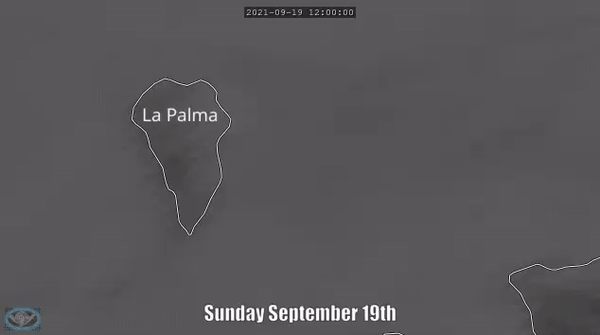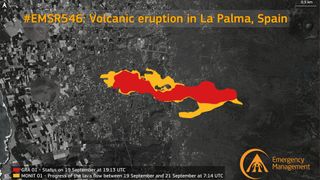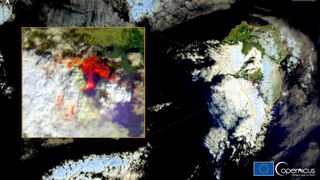Satellites watch as volcano erupts on Spanish island La Palma after half a century of silence

Satellites have been watching as the Cumbre Vieja volcano towering over the Spanish island of La Palma erupted for the first time since 1971 on Sunday (Sept.19), forcing evacuation of thousands of residents and tourists.
The European Sentinel-2 Earth-observing satellite imaged the eruption as it flew over the volcano on Monday (Sept. 20) and captured the plumes of smoke and streams of lava spilling from the volcano towards the western flank of the island, which is part of the Canary Island archipelago located off the coast of Morocco.
Sentinel 2 is part of the European Union's Earth observation program Copernicus. Scientists working with data from the program as part of the E.U. Copernicus Emergency Management Service revealed on Wednesday (Sept. 22) that lava from the eruption had already destroyed 320 buildings in the Los Llanos de Aridane region in the western part of the island. The boiling lava, which is slowly spreading towards the coast, now covers an area of more than 0.6 square miles (154 hectares).
Related: Images: 10 incredible volcanoes in our solar system

More than 6,000 people have been evacuated and further evacuations are under consideration as geologists fear the lava might trigger dangerous explosions and release toxic gas once it reaches the coast and mixes with the seawater, according to The Independent.
Scientists are also continuing to monitor the spread of the sulfur dioxide-rich volcanic smoke released by the eruption. According to the Copernicus Atmosphere Monitoring Service (CAMS), the plume will spread northwards from the island in the coming days and move over Spain and France by the end of this week.

Since the eruption started, desperate residents, rescue workers as well as news crews have shared images and footage of the damage caused by the slow-moving but unstoppable river of boiling lava.
Get the Space.com Newsletter
Breaking space news, the latest updates on rocket launches, skywatching events and more!
Twitter user @UK_Expat shared drone footage of swimming pools boiling as the scorching lava spilled inside.
Another user, called @ezequieleg968, shared frightening footage of the lava slowly creeping into the garden of a house.
Volcanic ash from the eruption has so far only prompted limited restrictions on air traffic on the island. According to the Volcanic Ash Advisory Center, satellite images reveal the presence of volcanic ash in the atmosphere as far as 34 miles northwest of the eruption site. No widespread air traffic restrictions are currently expected.
The Geostationary Operational Environmental Satellite (GOES) East, operated by the U.S. National Oceanic and Atmospheric Administration (NOAA), which covers mostly the eastern part of the Americas, also managed to capture the eruption from its altitude of 22,000 miles (36,000 km). The satellite's infrared images are revealing the thermal signature of the eruption.
Cumbre Vieja's last eruption took place in 1971. That eruption, however, was less significant than this current one and was not accompanied by Earth tremors. This time, geologists had detected over 22,000 minor earthquakes within one week prior to the eruption, which alerted them to the rising magma inside the volcano.

The Cumbre Vieja volcano is also the subject of a controversial scientific theory that predicts that at some point a powerful eruption will break up the La Palma island, sending a massive landslide into the ocean. This theory, published in 2001 in the journal Geophysical Research Letters, predicts that a 35 to 120-cubic-mile (150 to 500 cubic kilometers) chunk of the island could fall into the Atlantic Ocean, sending a tsunami as tall as 82 feet (25 m) into the U.S. Eastern Coast.
More recent studies, however, suggest that in the worst case, 19 cubic miles (80 cubic kilometers) of rock might slide off the volcano during a violent eruption, generating a wave that would be no more than 6.5 feet (2 m) tall by the time it reached the U.S.
Several scientists have spoken up publicly since the current eruption started, trying to dispel the concerns.
"The current eruption at La Palma? It's very, very likely to remain a local hazard," volcanologist and science journalist Robin George Andrews posted on Twitter. "So don't buy into any fearmongering."
Follow Tereza Pultarova on Twitter @TerezaPultarova. Follow us on Twitter @Spacedotcom and on Facebook.
Join our Space Forums to keep talking space on the latest missions, night sky and more! And if you have a news tip, correction or comment, let us know at: community@space.com.

Tereza is a London-based science and technology journalist, aspiring fiction writer and amateur gymnast. Originally from Prague, the Czech Republic, she spent the first seven years of her career working as a reporter, script-writer and presenter for various TV programmes of the Czech Public Service Television. She later took a career break to pursue further education and added a Master's in Science from the International Space University, France, to her Bachelor's in Journalism and Master's in Cultural Anthropology from Prague's Charles University. She worked as a reporter at the Engineering and Technology magazine, freelanced for a range of publications including Live Science, Space.com, Professional Engineering, Via Satellite and Space News and served as a maternity cover science editor at the European Space Agency.
